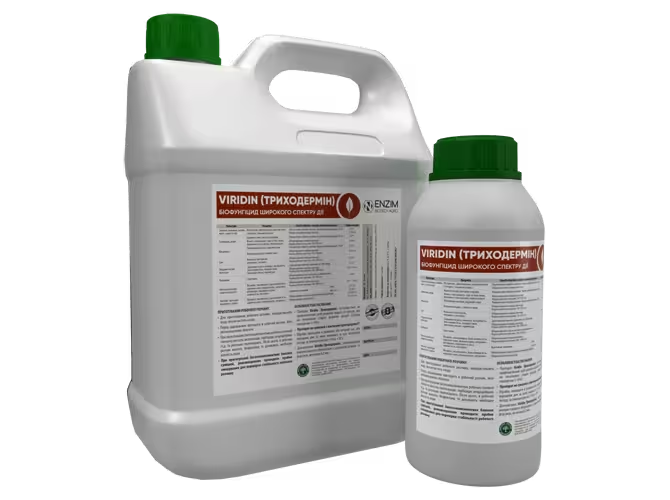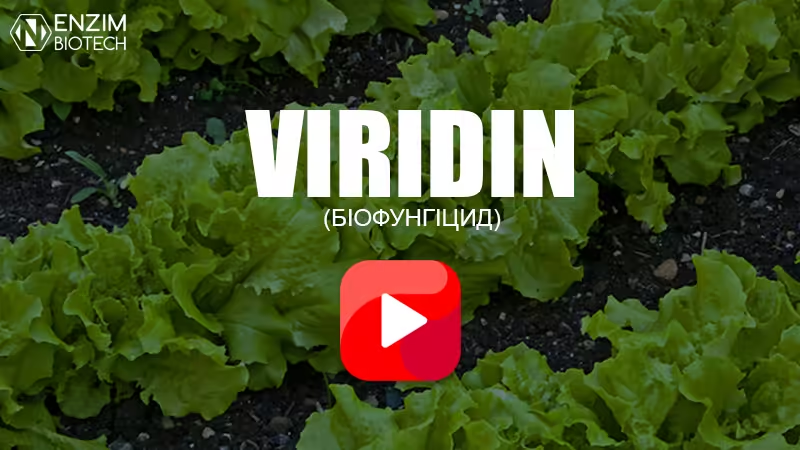Viridin Trichodermin

Biofungicide for plant protection
Biofungicide for plant protection against a wide range of fungal and bacterial diseases based on Trichoderma culture. It effectively inhibits pathogens and protects against fungal diseases.
Viridin© (Trichodermin) suppresses pathogens that spread through the soil and plant residues. Trichoderma culture parasitizes on sclerotia of the fungus Sclerotinia sclerotiorum, pseudosclerosis of the fungus Rhizoctonia solani, active against fungi of the genus Alternaria, Ascochyta, Botrytis, Verticillium, Colletotrichum, Fusarium, Helminthosporium, Pythium, Phoma, Phytophthora.
Viridin© (Trichodermin) inhibits the development of phytopathogens by direct parasite, by competition for substrates, by secretion of enzymes and antibiotics (gliotoxin, viridin, trichodermin, etc.) and other biologically active substances that inhibit the development of many species of pathogens and inhibit their reproductive capacity.
In soil the fungus develops on various plant residues rich in cellulose, on mycelium, on the fruit bodies of phytopathogens.
Viridin© (Trichodermin) effectively protects the following crops:
— cereals (wheat, rye, barley, corn);
— technical (sugar beet, rapeseed, sunflower, soybean);
— fruit and berries (apple, pear, cherry, plum, grapes, black currant, gooseberry and strawberry);
— vegetables on the open soil and in hothouses;
— roses in hothouses, ornamental trees and bushes;
— flower seedlings;
— indoor floral cultures.
- Product compatibility:
- Viridin© (Trichodermin) is compatible with chemical herbicides, insecticides and biological preparations. It has strong synergetic effect with the preparations Gaubsin FORTE, PhytoDoctor©, BioMag, Biophosphorin. It is incompatible with chemical fungicides.
- It is used in tank mixtures at +10 °C.
- Storage rules:
- Shelf life: 6 months from date of manufacture at temperature from +2 °C to +15 °C. The working solution should be used within 3 hours.
| culture | diseases | treatment method, consumption of working solution | consumption rate |
|---|---|---|---|
| Wheat, barley, rye, spring and winter | Fusariosis, ophiobolisis, root rot | Preseeding treatment of seeds. Working solution consumption is 10 l/t | 2 l/t |
| Septoria, gelmintosporium | Spraying during the growing season | 2 l/ha | |
| Sunflower, rapeseed | Root rot, bacteriosis of roots | Preseeding treatment of seeds. Working solution consumption is 10 l/t | 5 l/t |
| Phomosis, alternaria, gray and white rot, powdery mildew of rape, peronosporosis | Spraying during the growing season. Working solution consumption is 150-250 l/ha | 2 l/ha | |
| Corn | Seed mold, root rot | Preseeding treatment of seeds. Working solution consumption is 10 l/t | 5 l/t |
| Helmintosporium, stem rot | Spraying during the growing season. Working solution consumption is 150-250 l/ha | 2 l/ha | |
| Soy | Bacterial burn, anthracnose, septoriosis | Spraying during the growing season. Working solution consumption is 150-250 l/ha | 2 l/ha |
| Fruit and berry cultures | Powdery mildew, moniliosis, white spot, fruit rot, cocomycosis of cherries, black cancer | Soaking the roots of seedlings. Spraying during the growing season. The norm of the working solution 500-1000 l/ha | 5-10 l/ha |
| Strawberry | Gray rot | Spraying in the phase of flowering and berries ripening. Working solution consumption is 150-250 l/ha | 3 l/ha |
| Vegetable and flower-decorative cultures of open soil and in hothouses | Fusarium, Alternaria, brown spotting, root rot, peronosporosis, anthracnose, late blight, powdery mildew, spotting, bacteriosis | Spraying during the growing season. The norm of the working solution 500-1000 l/ha | 1,0-1,5 l/ha |
| Before adding the preparation to the working solution, the content should be thoroughly shaken, and it is recommended to pass at through a strainer. | |||
